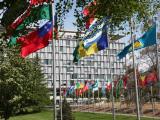Nov 13, 2009 (CIDRAP News) –Pandemic activity is showing early signs of peaking in some parts of North America, but is on the rise in several European countries as well as those in Central and Eastern Asia, the World Health Organization (WHO) reported today.
In the United States, southern and southeastern states that were among the first to report illness spikes at the end of the summer may have already seen a peak in cases, the WHO said in its weekly update today.
Meanwhile, pandemic activity has become more intense in Canada over the past 3 weeks, with illness increases spread from west to east. Health officials in British Columbia said yesterday that flu activity might be leveling off in the southern and central part of the province, according to a report today from the Metro Vancouver newspaper.
The WHO reported that flu activity in Mexico has also been widespread throughout the country since early September, particularly in the central and southern regions.
In Europe and Central Asia the virus is spreading eastward, but disease activity may be peaking in some areas that had early autumn outbreaks such as Iceland, Ireland, and parts of the United Kingdom, including Northern Ireland.
England's chief medical officer, Liam Donaldson, said yesterday that the country's number of new flu cases fell by a fourth last week, but he said it was too soon to say the pandemic has peaked and said the decrease in illnesses might be fueled by a school break, BBC News reported.
The WHO said today that its initial investigation into a sharp rise in cases in the Ukraine found that the numbers of severe cases were not out of line when compared with pandemic outbreaks in other countries and do not portray any changes in pandemic H1N1transmission or virulence.
The WHO's European regional office said in a statement yesterday that its investigators have returned to Kiev where they had meetings with the country's prime minister and president to discuss actions needed to slow the spread of the virus and which groups to prioritize for vaccination.
Though the WHO investigators in the Ukraine are still working on their final assessment, they said the country's health facilities are well prepared to manage the surge of flu cases.
More than 99% of the viruses subtyped in Europe are the pandemic H1N1 strain, except in the Russian Federation, where less than 10% were seasonal H3N2 and H1N1 subtypes.
Meanwhile, some Western Asian and Middle Eastern countries are reporting sharp increases over the past 3weeks, including Israel and Afghanistan. In Eastern Asia, Mongolia is reporting intense and increasing flu activity, which is severely affecting the country's healthcare system. Flu activity is increasing in China and Japan, but flu-like illnesses seem to be leveling off in Hong Kong and on Hokkaido, Japan's northern island.
Flu illness rates may have recently peaked in some Caribbean countries, the WHO said, adding that most countries in tropical regions of Central and South America report slowing flu activity. Transmission is also declining in most parts of South and Southeast Asia except for Nepal and Sri Lanka.
The only Southern Hemisphere location reporting unusual flu activity is Argentina, where a cluster of cases has been detected in the country's capital.
Three African countries recently reported their first confirmed pandemic H1N1 cases: Somalia, Nigeria, and Burundi.
So far at least 6,260 confirmed deaths from the virus have been reported to the WHO.
See also:
Nov 13 WHO pandemic update
Nov 13 MetroVancouver story
Nov 12 BBC News report


















